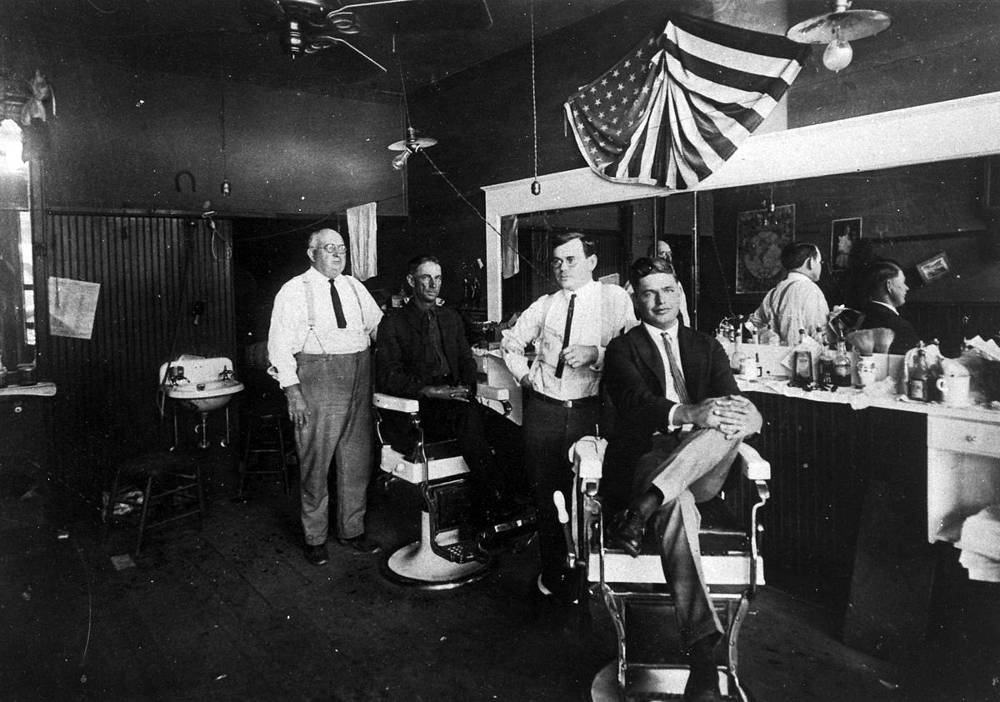[Photograph - Barber's shop circa 1920. African-American populations in the US were reported to be less likely to seek medical attention and medical check-ups for hypertension and colon cancer. So barber shops were used to educate these men about the need to do medical check-ups]
By: Neelima Mahajan
In every country, there are vast populations that need to be educated about something, like say personal health or hygiene, but it’s hard to do that because they are too poor, too busy, too old or just plain shy. Researchers at Harvard Kennedy School believe that a way of reaching them and achieving the desired outcome is to use a concept called ‘embedded education’. According to Jorrit de Jong, Lecturer in Public Policy and Management and Academic Director, Innovations in Government Program at Harvard Kennedy School’s Ash Center for Democratic Governance and Innovation, “Embedded education is the practice of educating people through encounters that they already have with existing delivery systems.”
“Embedded education is really finding another way to reach those people through natural touch points,” he adds.
The way it works is simple: if women who need to be educated about basic diseases are interacting with, say, a microfinance institution, the microfinance institution can be used as the touch point to deliver that education. “That’s not just a very efficient way to do it but also an effective way, because you are piggybacking on an existing encounter and embedding education in that encounter,” says de Jong.
In this interview, de Jong, who was in Beijing recently, explains how embedded education works and which situations it is most suitable for.

[Jorrit de Jong, Lecturer in Public Policy and Management and Academic Director, Innovations in Government Program at Harvard Kennedy School’s Ash Center for Democratic Governance and Innovation]
Q. What circumstances is embedded education best suited for and what are the situations where it is just not a good solution?
A. Traditional education basically requires people to dedicate time to this. If you’re very poor, your basic focus is on getting an income for the family, taking care of basic needs, so there’s no time and often no money to go to school. This is a really good way to reach populations that are financially disadvantaged. In addition to that, there are also populations that may have the time or money but are shy or reluctant to get the education they need. For example, in the Netherlands we have looked at people that are ‘low literate’: they may not be able to read and write sufficiently to participate in the society. They are typically ashamed to admit that they can’t read or write, so they won’t seek education for that. We looked at a project that targets those people when they are applying for social benefits or when they go to the hospital. So you are using the encounters that they have with other delivery systems, healthcare or social security, to target them and give them opportunities to increase their literacy. That’s a way to target populations that are out of formal education but could really benefit from it.
Q. While creating a system with embedded education, how do you ensure that the service provider has the inclination to go beyond just the ‘service’ and do an additional task? Do they need to be incentivized?
A. Let me answer by giving an example from Guangxi (China) where there was a problem with HIV infection. There were a lot of road workers, construction workers that were away from home, and sometimes they use the services of sexual workers. The problem was to get them educated about the risks of unsafe sex. Now obviously it’s going to be hard because it is a sensitive issue to get people to talk about this, to get the companies that these road workers work for to pay attention to this. But what we found is that both the companies and the government and the NGOs working on this felt a sense of urgency, because if this wasn’t stopped, it would have affected all parties. The government would have to deal with the problem because it spreads to the local communities, the families of the road workers back at home would be affected, and the company would be affected if people got sick.
So the first strategic challenge is to create the sense of urgency among the different stakeholders, private sector, non-profit sector, government, public sector. Once that has been created, the question becomes: how do you translate that into some operational mechanisms? And then we found that a combination of creating the trust between the foreman who would educate their co-workers or their subordinates, creating some incentives, paying people for the extra time they put into this, that really helps. But also a moral appeal, and it was really interesting to see that the foreman didn’t educate the road workers because they were paid for it or because they were told to do it. It was really because they cared about the road workers and they felt like we took this man from a different part of the country to build roads in Guangxi: when they go back, we want to deliver them home safely, and that doesn’t mean they still have all their arms and legs, it also means that they are still in good health. So more than anything it was the moral appeal of bringing those men back home safely that really motivated them to get engaged in this. It was highly successful.
Q. What about the issue of balancing the operators’ time and efforts spent between their core business and embedded education?
A. The first operational challenge is how to find the space and time to do it. Let me give you another example of barber shops in the US. African-American populations were reported to be less likely to seek medical attention and medical check-ups for hypertension and colon cancer. So barber shops were used to educate these men particularly about the need to do medical check-ups. And why were they approaching the barber shops? Because you have to figure out where people have some idle time: when you’re getting a haircut, you could talk about the weather, sports, recent events, you can also talk about personal health because you’re already in an encounter where getting a haircut is not about personal health, but it is about taking care of your body. So you are more likely to have a conversation there when you’re talking with your barber about personal health than for example, when you’re having a transaction with a bank, because it’s a different domain.
So when targeting this particular population, I felt like this is the most natural setting to try to educate people about that, and it worked. The results were really good. People were accepting the fact that they were targeted with these messages, so the embedded education encounter has to be resonant with the larger delivery system.
Q. How can you increase the effectiveness of embedded education? Given the contexts in which it is delivered, the consumer mindset may be very different at a point of time impacting the likely outcomes. For instance, if I am at a barber, I am probably in a very relaxed state of mind which perhaps makes me less open to talking about something serious, such as my heart health.
A. That is of course very tricky and it touches on another dimension. We have the operational challenge of shaping the encounter, shaping the message, the tools,… are you going to use posters, or conversation or an exercise? But there’s also strategic challenges: to what extent are barbershops willing to engage in this. They might actually lose customers: “I came here to get a haircut, I don’t need to be educated about anything here.” So the operational challenges are linked to the strategic challenges.
One of our findings from the field research here in China is that unless you address those strategic challenges, it’s going to be very hard to get to the operational challenges. And unless you really pay close attention to the operational challenges, you’re going to get into trouble at the strategic level, and you might lose the partners that you depend on for success. In those examples that are successful, a lot of attention was paid to operational details and strategic details. And there were a lot of iterations in the design process, so they never get it right the first time: they stuck with it and basically figured out how to make it work.
One of the purposes of this research is to really identify all the design variables, and get a better sense of what is the design space and what is the work involved to really utilize that design space. In such way you get to effective interventions.
Q. Can you talk about the experiments happening in China specifically? What kind of impact are we seeing here?
A. We have looked at two cases. One is called the HERproject which is managed by an organization called BSR, Business for Social Responsibility. They work in multiple provinces with women who work in factories. They are educating these women through peer to peer education. This is one way of addressing the variable trust: you want to make sure that the message is conveyed or the education is done through people they trust, and they trust peers.
At the strategic level the challenge is how do we get companies to free up time because this is happening during work hours for these women and their peers to engage in an educational encounter. Now this is part of the business case that BSR made that it’s going to be better for your returns. If the women know how to take better care of themselves and of their families, they’ll report sick less often and the research shows it really increased the compliance with health and safety regulations, which is good for the company. The decreased absenteeism was also notable so that’s good for the company, and worker satisfaction was better and there’s a projection that the worker retention is going to be better because women are not just here to work, they also get educated.
So it is seen as a perk. The hypothesis that we have is when it’s clear that embedded education not just benefits the client, the community, but also the company that’s working with you, and it supports government’s goals, then you’re in a very good place. In those cases, you see that the collaboration across sectors is really more than the sum of its parts.
Q. Even migrant workers and their families can afford mobile phones in China. Is putting an “educational message” over the mobile phone network, either SMS or WeChat, an option in embedded education?
A. I would imagine that in the next 5 years we’ll see a lot of those cases. The same principle still apply: how do you design the encounter because embedded education is different from broadcasting. Sending a message to a lot of people on their phones or tablets with information about their health, we call that broadcasting not education. Education requires some kind of interaction between an educator and a learner, so of course that can be done and is done through online platforms, but we haven’t found those examples that really in the same way take advantage of embedding an encounter in an existing system.
Funding for this research was provided by Cheung Kong Graduate School of Business (CKGSB) and the Hui Fund at the Ash Center at Harvard Kennedy School (HKS). The Embedded Education project is part of the collaboration between HKS and CKGSB.
[This article has been reproduced with permission from CKGSB Knowledge, the online research journal of the Cheung Kong Graduate School of Business (CKGSB), China's leading independent business school. For more articles on China business strategy, please visit CKGSB Knowledge.]


